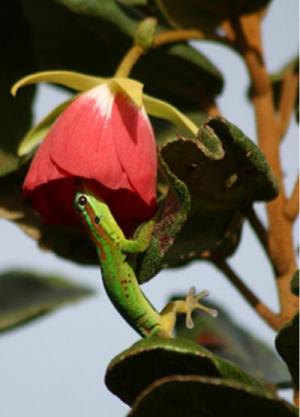
|
|
Trochetia boutoniana
flower and pollinator
Blue-tailed Day Gecko (Phelsuma cepediana)
|
Trochetia - Trochetia
spp.
Trochetia is a genus of flowering plants from the family Malvaceae (formerly in the
Sterculiaceae, but this family is now usually subsumed in the Malvaceae). They are endemic to the Mascarene
Islands.
The genus was first described by A.P. de Candolle in 1823, who named it in honour of French botanist Henri
Dutrochet.
The genus Trochetia consists of scrubs or small trees, which can reach a height from two to eight
metres. The hermaphroditic flowers are either white (T. triflora), pink (T.
parviflora), or reddish orange (T. boutoniana). They are either single-standing, or grow in a cluster of three
flowers. Some species have bell-shaped petals. All plants of this genus are imperiled due to the competition of invasive
species, like the guavas from China but also by the destruction of introduced monkeys and
rats. Five species occur on Mauritius and one on La Reunion. The habitat consists of humid forests with a high annual rainfall or mountainous slopes which are directed
windwards.
Trochetia boutoniana also known by its native Mauritian name Boucle d'Oreille
(in English: Earring tree, because of its bell-shaped look) is a shrub from the Trochetia genus endemic to
Mauritius. Traditionally included in the family Sterculiaceae, it is included in the expanded Malvaceae in the APG and most subsequent
systematics. It can reach a height up to 3 m. The leaves are oval shaped and due to its xerophyte adaptions it is leathery on the
underparts. Also stipules are present. The petals are between 5 and 6 cm and they are growing
asymmetric. They are bell-shaped and the coloring is dark red with a white
background. The capsule is globular shaped and containts up to 10 black seeds. The flowering time is from June to
October.
This plant is relatively rare because of its weak regeneration and due to introduced monkeys which feed from the blossom
buds. The only occurrence are the slopes of Le Morne Brabant, Mauritius. Thanks to the efforts of botanist Joseph Gueho it was successfully germinate and grown in cultivation for the first time in 1973.
Trochetia boutoniana is the national flower of Mauritius since 1992 and it is often illustrated on stamps of
Mauritius. It was named after French botanist Louis Bouton.
Plants from the genus Trochetia belong to the few plants worldwide that can produce coloured
nectar. Some scientists, like the Danish ecologist Jens Olesen assume that this could be linked to bird species which have pollinated this plants in the past and are extinct today[1].
However, recent research has demonstrated that not only do endemic Phelsuma geckos pollinate some of the
species, but that they actually prefer coloured over clear nectar. Hence, the 'mystery of the Mauritian coloured nectar can be considered at least partly solved
now. Whether the nectar-feeding birds in Mauritius also react to the coloured nectar as a signal for floral reward remains to be
seen.
The main pollinators of today are the Mauritius Olive White-eye (Zosterops
chloronothos) and the Mauritius Grey White-eye (Zosterops borbonicus mauritianus), introduced honey
bees, or geckos from the genus Phelsuma.
Recent research has shown that in the absence of the locally extinct Mauritius Olive
White-eye, Trochetia blackburniana's main pollinator in the area of Le Petrin is the
Blue-tailed Day Gecko (Phelsuma cepediana). Interestingly, the pollination efficiency of these geckos depend on the proximity to dense patches of
Pandanus, which are a favourite microhabitat for the geckos - possibly because the spiky leaves of Pandanus protect them from their main
predator, the Mauritius Kestrel (Falco punctatus).
Source:
http://en.wikipedia.org/wiki/Trochetia
http://en.wikipedia.org/wiki/Trochetia_boutoniana
http://news.nationalgeographic.com/news/2007/04/070423-gecko.html
